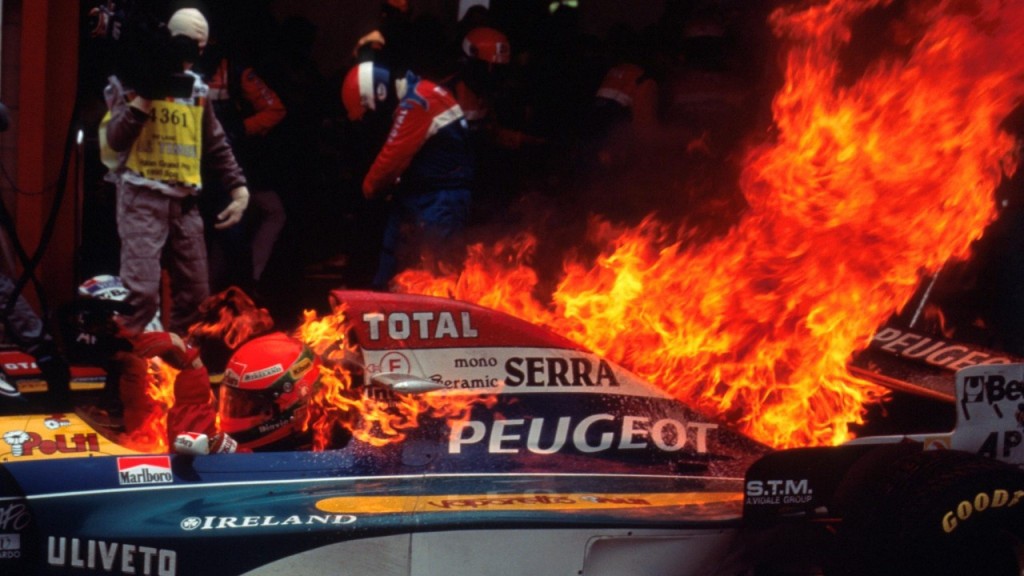The first Nomex suit used in motorsport was worn by Mel Kenyon in the 1966 Indy 500 but the technology soon made its way over to Europe with a young Mario Andretti one of the first to make the switch. The Nomex suits of this era were single layer as opposed to the triple layer designs of today so drivers were advised to supplement the suit with Nomex underwear too. Flame retardant pants have never really caught on beyond this and if you do feel a burning sensation in your undies you’re probably best consulting your local GP
It wasn’t until 1975 that the FIA imposed specific rules stating that all drivers must wear flame-retardant clothing, although at this time there was no definitive standard. So while some drivers took advantage of the newly developed two and three-layer Nomex technology others plumped for the proven ‘safety’ of flame retardant asbestos. Yup, asbestos. Many drivers of the era were essentially driving around in what can best be described as a carcinogenic hell-suit. Not only that but these were around five layers thick – sweaty and cumbersome (although, with hindsight, that was the least of their worries.)
The 80s saw perhaps the greatest forward strides in driver safety with constant evaluation and evolution of safer, lighter and more comfortable suits. The three layer Nomex suits became the overalls of choice for drivers and the first standard for a suit’s Thermal Protective Performance was introduced by the FIA in 1986 with a more comprehensive standard enforced in 2002.
Nowadays, every part of a driver’s outfit is scrutinised – fabric, zips, thread, seams, embroidery, elastic, socks, shoes, gloves, and even long underwear have to adhere to FIA standard 8856-2000, a far cry from the anything goes attitude of the early races in the 50s. The drivers of today could survive 35 seconds in temperatures of 850 degrees, around the same temperature as volcanic lava. The safety information learned at the race track – trials by fire so to speak – have helped the race industry improve every aspect of managing the threat of fire and protecting the people who provide the drama and spectacle of racing. Race apparel made with NOMEX® is at the core of this safety improvement.
That’s because racing material of DuPont NOMEX® brand fiber plays an important role in providing the valuable seconds race pros need to escape and survive intense fires that result from both on-track collisions and pit area accidents. And, this protection is long lasting. Whether it is found in protective suit, underwear, gloves or socks, the exceptional fire resistance provided by NOMEX® cannot be washed out or worn away.
Race gear of NOMEX® is innately fire-resistant, which means its resistance to flame is built into the fibers. It also will not sustain combustion in air or melt when exposed to fire. Because NOMEX® carbonizes and becomes thicker when exposed to intense heat, it forms a protective barrier between the heat source and the skin. This unique reaction to intense heat provides valuable escape time when flash fires occur and protects wearers against them. NOMEX® delivers confidence while managing heat and flames head on.
When protective material is tested on THERMO-MAN®, all systems are go
THERMO-MAN® is one of the most advanced testing methods for evaluating burn injury potential and measuring protective material performance. This scientific evaluation system for thermal burn injuries is a six-foot, one-inch-tall manikin equipped with 122 heat sensors. THERMO-MAN® can be exposed to various fire hazards through controlled burns to test burn protection properties of garment material constructions, fabric weights, material types and garment design styles. Results predict the amount, degree and location of burn injuries that would be suffered by the driver in a flash fire. DuPont scientists use this information to help apparel manufacturers develop optimum designs in lightweight, fire-resistant suits that equip drivers, pit crews, rescue teams and track officials with garments that are comfortable and provide the best thermal protection possible.
And, suits are just part of these professionals’ protection. One of the most effective ways they enhance their racing safety on the track is to increase the number of layers they wear. Because it provides thorough body coverage from neck to wrists to ankles, long johns of NOMEX® are one of several layers race drivers and pit crews put on before race time.

